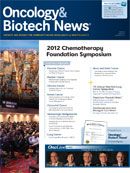Publication
Article
Oncology & Biotech News
Emerging Agents in Multiple Myeloma: An Overview
Author(s):
More potent versions of existing therapies are currently under development and showing considerable promise in early clinical trials for patients with multiple myeloma.
Sundar Jagannath, MD
Immunomodulatory drugs and proteasome inhibitors have revolutionized the treatment of multiple myeloma by improving patient response and survival. Now, newer and more potent versions of existing therapies are under development and showing considerable promise in early clinical trials. At the 2012 Chemotherapy Foundation Symposium, Sundar Jagannath, MD, presented a comprehensive review of several emerging multiple myeloma drugs.
In terms of immunomodulatory agents, pomalidomide appears to be building upon the success of its predecessors, including lenalidomide. Several clinical trials have confirmed the activity of pomalidomide in patients with multiple myeloma. For example, a study presented at the 2012 ASCO Annual Meeting showed that good responses were observed when pomalidomide was given with dexamethasone (J Clin Oncol. 2012;30[suppl; abstr 8016]).
In the phase II trial, patients refractory to lenalidomide, bortezomib, or both were randomized to receive pomalidomide with low-dose dexamethasone or pomalidomide alone. The overall response rate in the combination arm was 29% versus 15% with pomalidomide alone. Median progression-free survival was 3.8 months in patients receiving pomalidomide plus dexamethasone, as compared with 2.5 months with pomalidomide alone (hazard ratio = 0.73; P = .037).
Additionally, pomalidomide appears to work better when given in a 3-weekson/ 1-weekoff regimen, according to the results of a study presented at the 2011 American Society of Hematology (ASH) Annual Meeting (Blood. 2011;118[21]:812). Results of the IFM 2009-02 study showed that median time to first response, median duration of response, and the proportion of patients who were alive at least 1 year into the study were all higher in patients who received 3 weeks of pomalidomide followed by 1 week off with weekly dexamethasone compared with patients who received continuous pomalidomide with dexamethasone.
“These responses are durable and meaningful,” said Jagannath, who is director of the Multiple Myeloma Program at the Tisch Cancer Institute at Mount Sinai Medical Center in New York City. The FDA approved pomalidomide on February 8, 2013 (Find out more).
In addition to the next generation of immunomodulatory therapy, new proteasome inhibitors poised to improve upon bortezomib and carfilzomib are also in development. Jagannath highlighted two agents— ixazomib (MLN9708) and marizomib (NPI-0052)—that have yielded promising early data, and clinical trials continuing to assess their efficacy are currently enrolling patients.
Small studies of ixazomib, the first orally available proteasome inhibitor to enter clinical trials, were presented at ASH 2011 and ASCO 2012. These studies showed activity in heavily pretreated patients with multiple myeloma and suggested that the drug produced durable responses and disease control.
Blood
The study presented at ASH showed that six patients had achieved minimal response or better among 36 evaluable patients (. 2011;118[21]:301). Additionally, two of those patients achieved a partial response (PR) with duration of disease control of up to 11.3 months. Another 22 patients achieved stable disease.
J Clin Oncol
The study presented at ASCO further confirmed these positive ixazomib results. Of 53 evaluable relapsed and/or refractory patients, six achieved at least PR. Additionally, a duration of disease control of up to 21.1 months was observed (. 2012;30[suppl; abstr 8017]).
“There is reason to believe that this drug may be better than bortezomib and could be given orally,” Jagannath said.
Blood
Data on marizomib were also presented at ASH 2011. An interim analysis of 22 patients who received marizomib, the majority of whom were refractory to bortezomib, found that three had achieved PR. Those patients were evaluable in the active dose range of 0.4 to 0.6 mg/m2, and all were refractory to prior bortezomib. The median time on treatment was 1.5 months, and 16 patients (73%) achieved stable disease or better. The authors suggested further investigation of the drug in combination with lenalidomide and dexamethasone. Perhaps most significant, Jagannath noted, is the fact that peripheral neuropathy did not appear to be a side effect, since it is a significant adverse event associated with bortezomib (. 2011;118[21]:302).





























%20(2)%201-Recovered-Recovered-Recovered-Recovered-Recovered-Recovered-Recovered-Recovered-Recovered-Recovered-Recovered-Recovered-Recovered-Recovered-Recovered-Recovered-Recovered.jpg?fit=crop&auto=format)
%20(2)%201-Recovered-Recovered-Recovered-Recovered-Recovered-Recovered-Recovered-Recovered-Recovered-Recovered-Recovered-Recovered-Recovered-Recovered-Recovered-Recovered-Recovered.jpg?fit=crop&auto=format)
